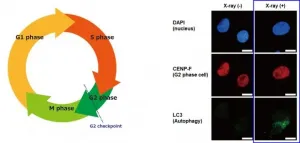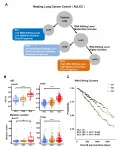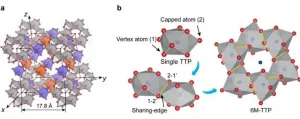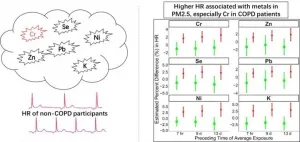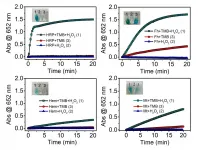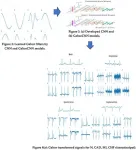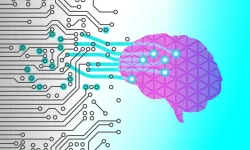(Press-News.org) Of all the different types of cancer known, a subtype of pancreatic cancer called pancreatic ductal adenocarcinoma (PDAC) is among the most aggressive and deadly. This disease begins in the cells that make up certain small ducts in the pancreas and progresses silently, usually causing no symptoms until advanced tumors actually obstruct these ducts or spread to other places. PDAC is not only difficult to diagnose, but also very unresponsive to available treatments. In particular, researchers have noted that PDAC cells can usually survive radiotherapy through mechanisms that remain largely unknown.
Part of the Radiation and Cancer Biology Group of the National Institutes for Quantum and Radiological Science and Technology, Japan, Dr. Sumitaka Hasegawa and colleagues Motofumi Suzuki and Mayuka Anko are currently studying what makes PDAC cells so radiation-resistant, and if there's a way to break through their defenses. In their latest study, published in the International Journal of Radiation Oncology, Biology, Physics, they've managed to uncover some of the mysteries underlying the curious relationship between treatment resistance in PDAC, the cell cycle, and a process called autophagy--or "self-digestion."
Every cell in our body is the result of the completion of countless cell cycles, from one cellular division to the next. Each cell cycle, shown schematically in Figure 1, is a chemically orchestrated sequence of phases in which a multitude of proteins actively control the growth of the cell and ensure it divides safely. When DNA damage is encountered, the cell cycle is halted at what's called the G2 checkpoint and division is postponed until the problem is fixed. In many types of cancers including PDAC, the G2 checkpoint is strongly activated after irradiation, which has been shown to increase resistance to therapy.
On the other hand, autophagy is a natural mechanism by which a cell digests some of its own organelles and proteins, especially damaged or unnecessary ones, to reclaim nutrients and maintain proper internal conditions, among other functions. While essential for healthy cells, researchers have found that autophagy increases in cancer cells right after radiation treatment and that it actually helps them endure and survive therapy.
Most interestingly, because autophagy and the G2 checkpoint share some of the same chemical signals, it has been suggested that these two processes are interrelated. "Although a relationship had been proposed, the mechanistic details of the interactions between autophagy and the G2 checkpoint after irradiation were unclear. Thus, in our recent study, we sought to understand more about the link between these processes, especially in PDAC cells," explains Dr. Hasegawa.
After numerous experiments in PDAC cell cultures, the team of scientists led by Dr. Hasegawa determined that irradiation-induced autophagy is dependent on the G2 checkpoint being activated. Moreover, they showed that autophagy helped the irradiated PDAC cells generate more energy (in the form of a molecule called ATP), which in turned led to their survival. Thus, the team proceeded to analyze what happened to irradiated PDAC cells when the G2 checkpoint was chemically inhibited. These irradiated cells, which could not activate the G2 checkpoint, did not undergo autophagy, and thus were much more likely to die post-radiation (Figure 2).
These promising results were then tested in mice onto which PDAC cells were transplanted to produce tumors. By treating these mice with both radiation and the G2 checkpoint inhibitor, the scientists managed to greatly suppress tumor growth compared to when irradiation was administered alone (Figure 3). In essence, this means that suppressors of the G2 checkpoint, which also mitigate autophagy, could be effectively used as tools to lower the radiation resistance of PDAC cells. "Our research," concludes Dr. Hasegawa, "should facilitate the development of radiosensitizers or new radiotherapeutic strategies for PDAC. In turn, this could largely improve the survival rate of patients with this type of cancer."
Further studies will be needed to better understand the connection between the G2 checkpoint and autophagy and how these processes make cancer cells more resistant. Let us hope scientists eventually find ways to effectively combat particularly difficult cancer types, such as PDAC, and give more years of life to affected people.
INFORMATION:
Research Article: Radiation-induced autophagy in human pancreatic cancer cells is critically dependent on G2 checkpoint activation: a mechanism of radioresistance in pancreatic cancer, International Journal of Radiation Oncology, Biology, Physics, Motofumi Suzuki , Mayuka Anko , Maki Ohara , Ken-ichiro Matsumoto and Sumitaka Hasegawa, DOI: https://doi.org/10.1016/j.ijrobp.2021.04.001
About Dr. Sumitaka Hasegawa from National Institutes for Quantum and Radiological Science and Technology, Japan:
Sumitaka Hasegawa is a physician-scientist and currently a group leader of the Radiation and Cancer Biology Group at the National Institutes for Quantum and Radiological Science and Technology, Japan. He graduated from Nagasaki University Graduate School of Biomedical Sciences after graduating from the medical school of Nagasaki University. He spent as a postdoc at UCLA and the Stanford University. He has many publications in the field of cancer research, radiation oncology, and nuclear medicine, including prestigious journals such as Nature, Science, Journal of the American Chemical Society, and the Proceedings of the National Academy of Sciences of the United States of America.
About National Institutes for Quantum and Radiological Science and Technology, Japan: The National Institutes for Quantum and Radiological Science and Technology (QST) was established in April 2016 to promote quantum science and technology in a comprehensive and integrated manner. QST's mission is to raise the level of quantum and radiological sciences and technologies through its commitment to research and development into quantum science and technology, the effect of radiation on humans, radiation emergency medicine, and the medical use of radiation. To ensure that research and development delivers significant academic, social and economic impacts, and to maximize benefits from global innovation, QST is striving to establish world-leading research and development platforms and explore new fields. Website: https://www.qst.go.jp/site/qst-english/
Funding information: This study was supported by the Japanese Society for the Promotion of Science KAKENHI (Grant number 18K15653 [MS]) and research grants from the National Institutes for Quantum and Radiological Science and Technology.
Media contact: Public Relations Section
Department of Management and Planning, QST
Tel: +81-43-206-3026 Email: info@qst.go.jp
A new physiological measurement of heart function developed at UVA Health could improve survival for people with heart failure by identifying high-risk patients who require tailored treatments, a new study suggests.
The study is the first to show a survival benefit from wireless pressure monitoring sensors implanted in the pulmonary arteries. Pulmonary artery proportional pulse pressure, or PAPP, is a new measure of heart function, developed at UVA, that can identify patients at very high risk of hospitalization or death from systolic heart failure or pulmonary hypertension (high blood pressure in the heart and ...
Tropical cyclones (TCs) are humbling and powerful forces of nature that can have tremendous impacts on people and human populations. Meteorologists have strived to improve TC forecasting skill, hoping to save lives. In the past few decades, TC track forecasts over the western North Pacific (WNP) have progressed considerably. However, TC intensity forecasts have improved insignificantly, with only a 3-5 day lead time. Therefore, improving TC intensity forecast skill and extending lead forecast time are important and urgent issues.
To address this critical problem, a research group led by Prof. Ruifen ZHAN from the Department of Atmospheric and Ocean Sciences/Institute of Atmospheric Sciences at Fudan University, along with the Shanghai Typhoon Institute of China Meteorological ...
The incidence rate of lung adenocarcinoma (LUAD) is increasing gradually and the mortality is still high. Recent advances in the genomic profile of LUAD have identified a number of driver alterations in specific genes, enabling molecular classification and targeted therapy accordingly. However, only a fraction of LUAD patients with those driver mutations could benefit from targeted therapy, and the remaining large numbers of patients were unclassified. RNA editing events are those nucleotide changes in the RNA. Currently, the role of RNA editing events ...
Glass is one of the most common subjects we see every day, but the detailed structure of this non-metallic and non-liquid material has always been a major mystery in science. A research team co-led by scientists at City University of Hong Kong (CityU) has successfully discovered that the amorphous and crystalline metallic glass have the same structural building blocks. And it is the connectivity between these blocks that distinguishes the crystalline and amorphous states of the material. The findings shed light on the understanding of glass structure.
Glass is a non-crystalline amorphous solid which has widespread practical and technological use in daily life. Besides the soda-lime glass used in windows, there are many other ...
Epidemiological and toxicological studies indicate that the adverse outcomes of PM2.5 exposure associated closely with the chemical composition in PM2.5. Metals in PM2.5 are highly concerned for their induced disruption of iron homeostasis in the lung and following oxidative stress, which is one of the key mechanisms underlying the cardiovascular autonomic dysfunction of PM2.5 exposure. However, there is no clear evidence on whether COPD patients are more susceptible to cardiovascular autonomic dysfunction associated with exposure to metals in ambient PM2.5 than individuals without COPD. Based on a panel study, the researchers directly compared metal-associated cardiovascular autonomic dysfunction between COPD patients and healthy controls.
"We observed higher levels of heart ...
Supermassive black holes (SMBH) occupy the center of galaxies, with masses ranging from one million to 10 billion solar masses. Some SMBHs are in a bright phase called active galactic nuclei (AGN).
AGNs will eventually burn out since there is a maximum mass limit for SMBHs; scientists have long since pondered when that will be.
Tohoku University's Kohei Ichikawa and his research group may have discovered an AGN towards the end of its life span by accident after catching an AGN signal from the Arp 187 galaxy.
Through observing the radio images in the galaxy using two astronomy observatories - the Atacama Large Millimeter/submillimeter Array (ALMA) and the Very Large Array (VLA) - ...
Globally, the Earth system has thousands of terragrams (Tg) (1 Tg = 10 12 g) of mineral nanoparticles moving around the planet each year. These mineral nanoparticles are ubiquitously distributed throughout the atmosphere, oceans, waters, soils, in and/or on most living organisms, and even within proteins such as ferritin. In natural environments, mineral nanozymes can be produced by two pathways: "top down" and "bottom up" processes. Specifically, the weathering or human-promoted breakdown of bulk materials can result in nanomaterials directly (a top-down process), or nanomaterials ...
A team of researchers from Nanyang Technological University, Singapore (NTU Singapore), Ngee Ann Polytechnic, Singapore (NP), and the National Heart Centre Singapore (NHCS) have invented a tool that could speed up the diagnosis of cardiovascular diseases.
Powered by artificial intelligence (AI), their innovation uses electrocardiograms (ECGs) to diagnose coronary artery disease, myocardial infarction and congestive heart failure to an accuracy of more than 98.5 per cent.
The joint development of the diagnostic tool is timely, as the number of deaths caused by cardiovascular disease in Singapore has increased over the past three years. According to the Singapore Heart Foundation, 29.3 per cent of all deaths in Singapore in 2019, or almost 1 out of 3 deaths in Singapore, was due to heart ...
Osteoporosis is a condition that does not exhibit symptoms until there is a bone fracture, so it is said that there is a high percentage of people who remain unaware of their condition. When people are unaware their bones have weakened, the condition is left untreated, and the recent rise of the elderly population has caused an increase in bone fractures. This has a large societal impact, such as overwhelming medical costs and long-term care. Simple screenings at resident health exams are one way for an increase in osteoporosis detecting without having to go to the hospital. When suspected osteoporosis and osteopenia is properly detected and patients are encouraged to get further evaluation at the hospital, ...
Scientists have observed for the first time what it looks like in the key memory region of the brain when a mistake is made during a memory trial. The findings have implications for Alzheimer's disease research and advancements in memory storage and enhancement, with a discovery that also provides a view into differences between the physiological events in the brain during a correct memory versus a faulty one.
The study was published today in the journal Nature Communications.
In both correct and incorrect recall of a spatial memory, researchers could observe patterns of cell activation in the brain that were similar, though the pace of activation differed.
"We could see the memories activating," said Laura Colgin, an associate professor of neuroscience at The University ...
